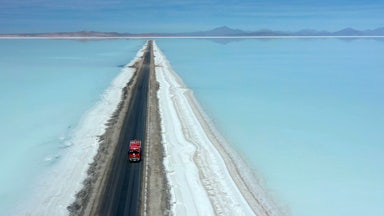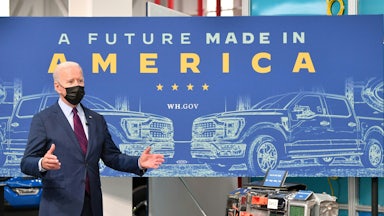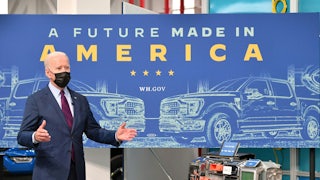In March’s final days, President Biden announced he would invoke the Korean War–era Defense Production Act, or DPA, to accelerate the domestic production of “strategic and critical minerals” used in the batteries that power clean energy technologies. Alongside the plan to release one million barrels per day from the Strategic Petroleum Reserve, Biden said his presidential determination was part of a two-pronged effort to lower gas prices and “lay a new foundation for true and lasting American energy independence.”
But Biden’s pursuit of a greener energy independence could run into the same problems his predecessors’ have in trying to build a fossil fueled one: “True” energy independence is virtually impossible, especially in the punishingly short window left to radically reduce emissions. As the last few months have shown, America’s status as the world’s largest oil and gas producer—now on track to become its biggest gas exporter—hasn’t freed it from either thorny geopolitics or speculative commodity traders. Critical minerals are not exempt from these forces.
Reducing energy demand via investments in energy efficiency, for instance—like weatherizing homes or installing heat pumps—is one of the more immediate options for freeing up oil and gas that’s already being drilled, which could then be rerouted to relieve Europe’s energy crisis. Yet while the administration has pledged to work alongside the European Union in boosting energy efficiency abroad, it so far hasn’t signaled a similarly ambitious effort at home. Reducing energy demand domestically could also help lessen the country’s dependence on ever more volatile markets for critical minerals—along with the environmental toll posed by new mining.
Simply boosting production, though, doesn’t address the planning challenges bound up in decarbonization and extraction itself. “There are tools that you can use to directly regulate extraction,” said Thea Riofrancos, a political scientist at Providence College and author of a new brief from the Climate and Communities Project, or CCP, on clean energy supply chains. “But if you’re not thinking about what drives extraction in the first place—further down the supply chain—then ultimately you’re going to end up defensively regulating something harmful rather than reducing the amount of mining that takes place.”
Riofrancos and CCP recommend a more holistic approach: reforming the archaic rules that govern mining to incorporate labor and environmental protections; recognizing the Free Prior and Informed Consent of Indigenous peoples; investing in public R&D rather than subsidizing private studies; limiting demand through critical minerals recycling programs; and doubling down on “mass transit, micromobility, and a built environment that is not engineered for car dependency,” per the CCP brief. “A car-centric path of decarbonization risks being both slower at cutting emissions and more mineral-intensive than an approach that rapidly scales up public transit,” it adds. CCP also cites a report from Earthworks that finds that—by 2040—mineral recycling infrastructure could reduce demand for lithium and copper by 25 and 55 percent, respectively, and by 35 percent for both nickel and cobalt.
Much of Biden’s recent DPA “determination,” as it’s called, for critical minerals simply copies and pastes sections of the Defense Production Act of 1950, broadening that law to encompass lithium, nickel, cobalt, graphite, and manganese. The determination specifically allows for the $750 billion in Pentagon funds allocated under Title III of the DPA to be used for reducing dependence on “unreliable foreign sources” in the clean energy supply chains. For now, that means being able to furnish loan guarantees for feasibility studies for new mines and upgrading existing production sites.
/ In honor of Earth Day, Apocalypse Soon content is free to registered users until April 29. Start reading now.
Though mining companies have been enthusiastic about the news, it’s not clear what this means in the longer term. “If you really wanted to get those mines built—and I hate to say this because we oppose it—you would strip away environmental review protections: permitting,” said Patrick Donnelly, the Nevada-based Great Basin director at the Center for Biological Diversity, or CBD, told me over the phone. “We’re glad they didn’t do that, but as a result I think the effects of the DPA are going to be modest.” (Defense Department official Jessica Maxwell told E&E News that the DPA announcement was “completely unrelated to the permitting process.”)
The United States currently has just one operational lithium mine—a site in Nevada owned by the North Carolina–based firm Albemarle. New mines take anywhere from seven to 20 years to start producing. Exploratory lithium projects are multiplying rapidly in the Silver State, Donnelly told me. Many of those are helmed by companies operating in a kind of regulatory Wild West, staking claims to lithium deposits and then raising small sums on foreign stock exchanges to start poking holes in the ground—all with precious little federal oversight. “Anybody can go out and stake a claim. All you’ve got to do is put a stake in the ground and report it to the Bureau of Land Management,” Donnelly said. He maintains a map of the more than 50 active and dormant lithium projects throughout the state, many of which have cropped up in the last few years. “Some of these are just a website and some claims and maybe a hole in the ground. I’m tracking it because no one else is,” he said.
“Hard-rock” mining of the sort used to extract lithium and other metals critical to the clean energy future is governed by an antiquated law written for gold prospecting. Reflecting the ethos of the day, the 1872 Mining Law doesn’t contain any environmental protections. Since it establishes that mining is the “best and highest use” of federal lands, it allows mining permits to take precedence over other uses—including oil and gas. Though nearly 80 percent of lithium deposits are within 35 miles of Indigenous reservations, tribes don’t need to be consulted or informed about claims on their land. The mining law offers them no legal recourse to challenge new projects. In contrast to oil and gas drilling, it also allows companies to pay no royalties on extraction from publicly owned minerals like lithium. The U.S. already captures relatively little of the resource wealth produced on its land compared to other major oil and gas producers like Norway, where oil revenues furnish a massive sovereign wealth fund. If mining statutes remain as they are, the government stands to capture even less from the minerals that will power a low-carbon future.
The Department of Interior launched an interagency working group in late February to reform the 150-year old law. The working group is focused on “respecting our obligations to Tribal Nations, Western communities, taxpayers, the environment, and future generations,” according to a press release announcing it. As Jael Holzman and Hannah Northey pointed out in E&E News, it may well also be aimed at streamlining regulatory processes.
The working group’s formation was a response to language in the Bipartisan Infrastructure Bill, which instructs the government to explore “additional measures, including regulatory and legislative proposals, if appropriate, that would increase the timeliness of permitting activities for the exploration and development of domestic critical minerals.” That’s what the Trump administration did in fast-tracking the approval of a 1,000-acre open-pit mine in Thacker Pass, spearheaded by a subsidiary of the Canadian firm Lithium Americas. That project has been held up by fierce protests and legal challenges led by nearby Indigenous communities, citing its threat to local water supplies, air quality, and biodiversity. As with most mining operations, the machinery used to dig up the minerals needed for renewable energy overwhelmingly run on fossil fuels. Attorneys from the Reno-Sparks Indian Colony—representing members of the Paiute, Shoshone, and Washoe tribes—have argued that Peehee Mu’huh (the Paiute name for Thacker Pass) contains “a massacre site, historic properties, and hunting and gathering grounds important to the region’s tribes.” The mine’s construction, they argue, would therefore violate the National Historic Preservation Act.
Indigenous tribes and environmental groups—long critical of the lax rules that govern mining—have argued that the Interior Department could place more stringent requirements on mining using its existing regulatory authorities. So far there hasn’t been much progress reforming the 1872 laws in Congress. Last year, New Mexico Senator Catherine Cortez Masto, a Democrat, helped strip language from her party’s reconciliation bill that would have levied the first-ever royalties on hard-rock mining for critical minerals like lithium. The revenue would have funded less than $1 billion in cleanup efforts on abandoned mines.
“If you’re going to be enthusiastically in support of [electric vehicles], you need to be enthusiastically in support of lithium production,” said Donnelly. “That’s a very uncomfortable position to be in,” he added. CBD has vigorously opposed proposed lithium developments like one at Rhyolite Ridge, while its staff in Washington supports federal climate legislation that would expand electric vehicle use. “If you’re staking out that short-term position—that E.V.s are a way out of the climate crisis—then we have no choice but to find some way of producing lithium that isn’t a total biodiversity apocalypse.”
For now, the U.S. isn’t producing much lithium at all, thanks to its single mine in Nevada. Lithium demand is projected to grow by 4,200 percent by 2040, though. Laid against the seven to 20 years it takes new mines to start producing, that’s a sobering figure. It means that if this country is planning to do its part in peaking global emissions by 2025—per the Intergovernmental Panel on Climate Change’s latest report—there’s a choice to make: The U.S. can rapidly bring down its emissions, or it can insist on total energy and mineral independence. It can’t do both.
The U.S. is “third in a three-horse race,” of E.V. supply chains, said Chris Berry, founder and president of the boutique energy supply chain consultancy House Mountain Partners. The first two are China and the European Union. He welcomed the DPA invocation and the administration’s all-of-government approach to critical mineral supply chains, though he wished it included permitting reform. “It will not necessarily expedite the production of critical materials on U.S. soil, but I’d rather have it in place and involved than not,” he told me of the DPA announcement.
Asked whether insisting batteries be completely “made in America” was compatible with peaking emissions by 2025, Berry said, “No. We will not be able to build a self-reliant critical minerals supply chain in the next three years.” He estimates that could happen by 2030 at the earliest, at which point global emissions will need to have been cut in half to salvage a chance at limiting warming to 1.5 degrees Celsius (2.7 degrees Fahrenheit), while emphasizing the need to work with friendly countries with major existing mining operations like Australia and Chile. Replicating (or “reshoring”) complete clean energy supply chains could take even longer.
China has been building decarbonization into its Five Year Plans for quite a while now. Last year, China sold five times as many E.V.s as the U.S. Start-up electric vehicle manufacturers here have been struggling to produce cars, and major U.S. automakers are already behind when it comes to securing the materials needed to quickly ramp up the various moving parts of domestic E.V. production. “You can build a battery plant much faster than you can make a lithium mine. All those battery plants are competing over the same stock of lithium,” Riofrancos told me.
The legacy automakers, Berry said, “are too late. If they don’t have long-term off-take agreements [where miners agree to supply at steady or more gradually rising prices for several years] for lithium locked up today, you’ve got a real problem on your hands in terms of getting affordable supply.” Now that lithium prices are surging, automakers without prior off-take agreements could pay tens of thousands of dollars more per ton, as they compete for the roughly 10 percent of lithium that’s available on the spot market. In 2019, that price stood at around $13,000 per metric ton. Today’s it’s around $78,000 per metric ton.
Clean energy boosters have been keen to point to technologies getting exponentially cheaper, but thanks to skyrocketing commodity prices that’s likely not the case when it comes to batteries—at least not yet. After years of decline, battery prices plateaued for the first time last year and might now increase thanks to rising commodity prices.
These dynamics are why Biden invoking the DPA probably won’t do much, whereas setting up a serious domestic lithium recycling program and encouraging a less mineral-intensive transit program (among other measures) might. No one I spoke with opposed some degree of onshoring for critical mineral production. But they worried about prioritizing geopolitical dominance over either rapid decarbonization or the environmental and sovereignty concerns that have stymied new lithium developments the world over. The Biden administration, Donnelly said, “could head off a lot of the problems with permitting by doing some pretty explicit and detailed geospatial planning,” incorporating concern for biodiversity and Indigenous sovereignty, and scaling up more responsible mineral production where appropriate. Instead, with or without the latest DPA determination, Donnelly says, “there’s no plan for how we’re going to have our renewable energy transition and produce critical minerals. Until there’s a plan, we’re all kind of flailing around in the dark.”










